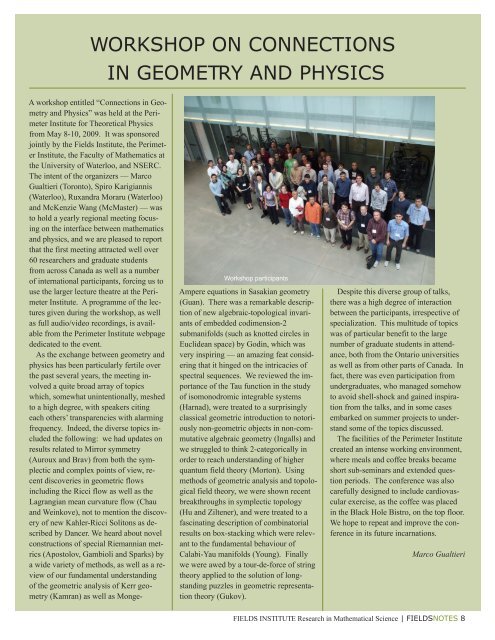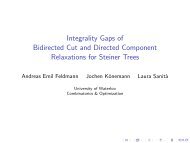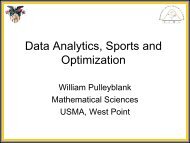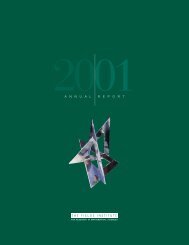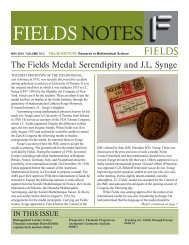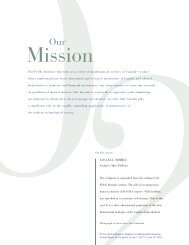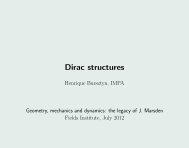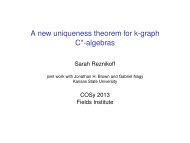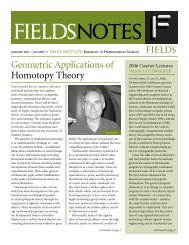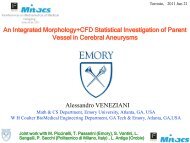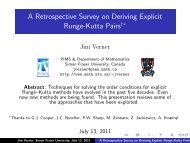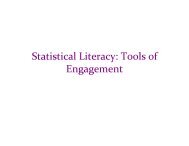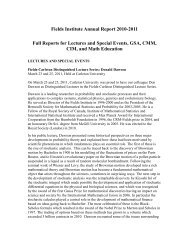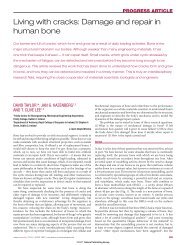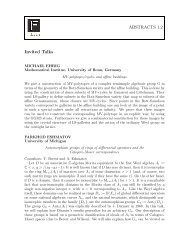Fields Notes, September 2009 - Fields Institute - University of Toronto
Fields Notes, September 2009 - Fields Institute - University of Toronto
Fields Notes, September 2009 - Fields Institute - University of Toronto
You also want an ePaper? Increase the reach of your titles
YUMPU automatically turns print PDFs into web optimized ePapers that Google loves.
WORKSHOP ON CONNECTIONS<br />
A workshop entitled “Connections in Geometry<br />
and Physics” was held at the Perimeter<br />
<strong>Institute</strong> for Theoretical Physics<br />
from May 810, <strong>2009</strong>. It was sponsored<br />
jointly by the <strong>Fields</strong> <strong>Institute</strong>, the Perimeter<br />
<strong>Institute</strong>, the Faculty <strong>of</strong> Mathematics at<br />
the <strong>University</strong> <strong>of</strong> Waterloo, and NSERC.<br />
The intent <strong>of</strong> the organizers — Marco<br />
Gualtieri (<strong>Toronto</strong>), Spiro Karigiannis<br />
(Waterloo), Ruxandra Moraru (Waterloo)<br />
and McKenzie Wang (McMaster) — was<br />
to hold a yearly regional meeting focusing<br />
on the interface between mathematics<br />
and physics, and we are pleased to report<br />
that the first meeting attracted well over<br />
60 researchers and graduate students<br />
from across Canada as well as a number<br />
<strong>of</strong> international participants, forcing us to<br />
use the larger lecture theatre at the Perimeter<br />
<strong>Institute</strong>. A programme <strong>of</strong> the lectures<br />
given during the workshop, as well<br />
as full audio/video recordings, is available<br />
from the Perimeter <strong>Institute</strong> webpage<br />
dedicated to the event.<br />
As the exchange between geometry and<br />
physics has been particularly fertile over<br />
the past several years, the meeting involved<br />
a quite broad array <strong>of</strong> topics<br />
which, somewhat unintentionally, meshed<br />
to a high degree, with speakers citing<br />
each others’ transparencies with alarming<br />
frequency. Indeed, the diverse topics included<br />
the following: we had updates on<br />
results related to Mirror symmetry<br />
(Auroux and Brav) from both the symplectic<br />
and complex points <strong>of</strong> view, recent<br />
discoveries in geometric flows<br />
including the Ricci flow as well as the<br />
Lagrangian mean curvature flow (Chau<br />
and Weinkove), not to mention the discovery<br />
<strong>of</strong> new KahlerRicci Solitons as described<br />
by Dancer. We heard about novel<br />
constructions <strong>of</strong> special Riemannian metrics<br />
(Apostolov, Gambioli and Sparks) by<br />
a wide variety <strong>of</strong> methods, as well as a review<br />
<strong>of</strong> our fundamental understanding<br />
<strong>of</strong> the geometric analysis <strong>of</strong> Kerr geometry<br />
(Kamran) as well as Monge<br />
IN GEOMETRY AND PHYSICS<br />
Workshop participants<br />
Ampere equations in Sasakian geometry<br />
(Guan). There was a remarkable description<br />
<strong>of</strong> new algebraictopological invariants<br />
<strong>of</strong> embedded codimension2<br />
submanifolds (such as knotted circles in<br />
Euclidean space) by Godin, which was<br />
very inspiring — an amazing feat considering<br />
that it hinged on the intricacies <strong>of</strong><br />
spectral sequences. We reviewed the importance<br />
<strong>of</strong> the Tau function in the study<br />
<strong>of</strong> isomonodromic integrable systems<br />
(Harnad), were treated to a surprisingly<br />
classical geometric introduction to notoriously<br />
nongeometric objects in noncommutative<br />
algebraic geometry (Ingalls) and<br />
we struggled to think 2categorically in<br />
order to reach understanding <strong>of</strong> higher<br />
quantum field theory (Morton). Using<br />
methods <strong>of</strong> geometric analysis and topological<br />
field theory, we were shown recent<br />
breakthroughs in symplectic topology<br />
(Hu and Ziltener), and were treated to a<br />
fascinating description <strong>of</strong> combinatorial<br />
results on boxstacking which were relevant<br />
to the fundamental behaviour <strong>of</strong><br />
CalabiYau manifolds (Young). Finally<br />
we were awed by a tourdeforce <strong>of</strong> string<br />
theory applied to the solution <strong>of</strong> longstanding<br />
puzzles in geometric representation<br />
theory (Gukov).<br />
Despite this diverse group <strong>of</strong> talks,<br />
there was a high degree <strong>of</strong> interaction<br />
between the participants, irrespective <strong>of</strong><br />
specialization. This multitude <strong>of</strong> topics<br />
was <strong>of</strong> particular benefit to the large<br />
number <strong>of</strong> graduate students in attendance,<br />
both from the Ontario universities<br />
as well as from other parts <strong>of</strong> Canada. In<br />
fact, there was even participation from<br />
undergraduates, who managed somehow<br />
to avoid shellshock and gained inspiration<br />
from the talks, and in some cases<br />
embarked on summer projects to understand<br />
some <strong>of</strong> the topics discussed.<br />
The facilities <strong>of</strong> the Perimeter <strong>Institute</strong><br />
created an intense working environment,<br />
where meals and c<strong>of</strong>fee breaks became<br />
short subseminars and extended question<br />
periods. The conference was also<br />
carefully designed to include cardiovascular<br />
exercise, as the c<strong>of</strong>fee was placed<br />
in the Black Hole Bistro, on the top floor.<br />
We hope to repeat and improve the conference<br />
in its future incarnations.<br />
Marco Gualtieri<br />
FIELDS INSTITUTE Research in Mathematical Science | FIELDSNOTES 8


